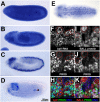Bällchen participates in proliferation control and prevents the differentiation of Drosophila melanogaster neuronal stem cells
- PMID: 25190057
- PMCID: PMC4197436
- DOI: 10.1242/bio.20148631
Bällchen participates in proliferation control and prevents the differentiation of Drosophila melanogaster neuronal stem cells
Abstract
Stem cells continuously generate differentiating daughter cells and are essential for tissue homeostasis and development. Their capacity to self-renew as undifferentiated and actively dividing cells is controlled by either external signals from a cellular environment, the stem cell niche, or asymmetric distribution of cell fate determinants during cell division. Here we report that the protein kinase Bällchen (BALL) is required to prevent differentiation as well as to maintain normal proliferation of neuronal stem cells of Drosophila melanogaster, called neuroblasts. Our results show that the brains of ball mutant larvae are severely reduced in size, which is caused by a reduced proliferation rate of the neuroblasts. Moreover, ball mutant neuroblasts gradually lose the expression of the neuroblast determinants Miranda and aPKC, suggesting their premature differentiation. Our results indicate that BALL represents a novel cell intrinsic factor with a dual function regulating the proliferative capacity and the differentiation status of neuronal stem cells during development.
Keywords: Bällchen; Drosophila; Neuroblasts; Stem cells.
© 2014. Published by The Company of Biologists Ltd.
Conflict of interest statement
Figures




Similar articles
-
Bällchen is required for self-renewal of germline stem cells in Drosophila melanogaster.Biol Open. 2014 May 29;3(6):510-21. doi: 10.1242/bio.20147690. Biol Open. 2014. PMID: 24876388 Free PMC article.
-
Lgl, Pins and aPKC regulate neuroblast self-renewal versus differentiation.Nature. 2006 Feb 2;439(7076):594-8. doi: 10.1038/nature04299. Epub 2005 Dec 14. Nature. 2006. PMID: 16357871
-
Twins/PP2A regulates aPKC to control neuroblast cell polarity and self-renewal.Dev Biol. 2009 Jun 15;330(2):399-405. doi: 10.1016/j.ydbio.2009.04.014. Epub 2009 Apr 15. Dev Biol. 2009. PMID: 19374896 Free PMC article.
-
Control of neural stem cell self-renewal and differentiation in Drosophila.Cell Tissue Res. 2015 Jan;359(1):33-45. doi: 10.1007/s00441-014-1914-9. Epub 2014 Jun 6. Cell Tissue Res. 2015. PMID: 24902665 Review.
-
Drosophila neural stem cells: cell cycle control of self-renewal, differentiation, and termination in brain development.Results Probl Cell Differ. 2011;53:529-46. doi: 10.1007/978-3-642-19065-0_21. Results Probl Cell Differ. 2011. PMID: 21630158 Review.
Cited by
-
Obscure functions: the location-function relationship of obscurins.Biophys Rev. 2017 Jun;9(3):245-258. doi: 10.1007/s12551-017-0254-x. Epub 2017 Mar 29. Biophys Rev. 2017. PMID: 28510116 Free PMC article. Review.
-
A genome-wide RNAi screen for genes important for proliferation of cultured Drosophila cells at low temperature identifies the Ball/VRK protein kinase.Chromosoma. 2023 Mar;132(1):31-53. doi: 10.1007/s00412-023-00787-6. Epub 2023 Feb 7. Chromosoma. 2023. PMID: 36746786 Free PMC article.
-
Binding partners of the kinase domains in Drosophila obscurin and their effect on the structure of the flight muscle.J Cell Sci. 2015 Sep 15;128(18):3386-97. doi: 10.1242/jcs.170639. Epub 2015 Aug 6. J Cell Sci. 2015. PMID: 26251439 Free PMC article.
-
Mutations in ANKLE2, a ZIKA Virus Target, Disrupt an Asymmetric Cell Division Pathway in Drosophila Neuroblasts to Cause Microcephaly.Dev Cell. 2019 Dec 16;51(6):713-729.e6. doi: 10.1016/j.devcel.2019.10.009. Epub 2019 Nov 14. Dev Cell. 2019. PMID: 31735666 Free PMC article.
-
Kinome-Wide RNAi Screen Uncovers Role of Ballchen in Maintenance of Gene Activation by Trithorax Group in Drosophila.Front Cell Dev Biol. 2021 Mar 5;9:637873. doi: 10.3389/fcell.2021.637873. eCollection 2021. Front Cell Dev Biol. 2021. PMID: 33748127 Free PMC article.
References
-
- Berger C., Harzer H., Burkard T. R., Steinmann J., van der Horst S., Laurenson A.-S., Novatchkova M., Reichert H., Knoblich J. A. (2012). FACS purification and transcriptome analysis of Drosophila neural stem cells reveals a role for Klumpfuss in self-renewal. Cell Reports 2, 407–418 10.1016/j.celrep.2012.07.008 - DOI - PMC - PubMed
Grants and funding
LinkOut - more resources
Full Text Sources
Other Literature Sources
Molecular Biology Databases

